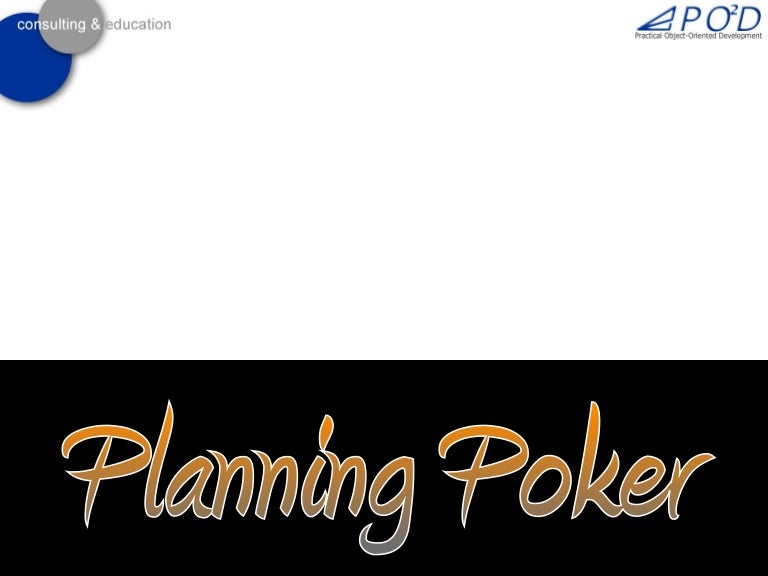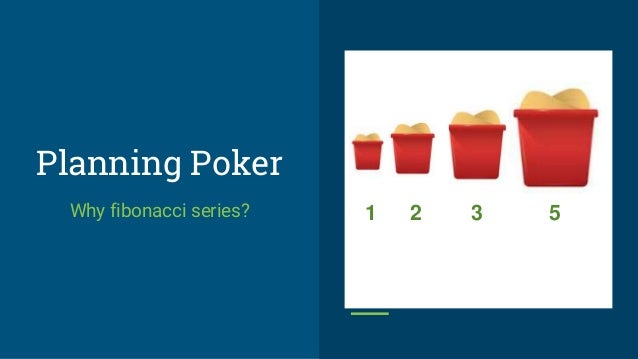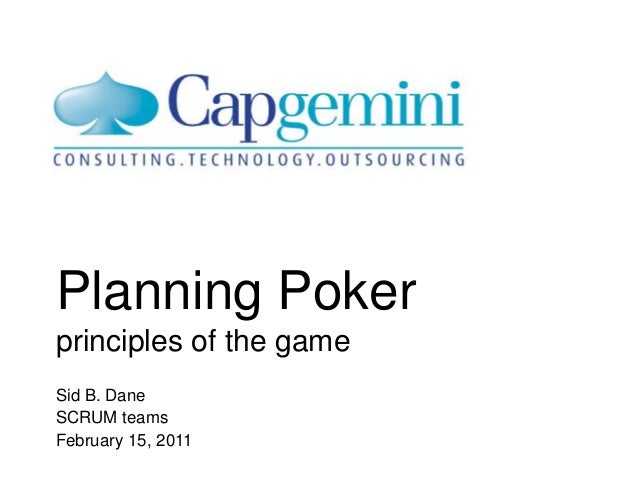Planning Poker Slideshare
- Planning Poker Slideshare Download
- Planning Poker Slideshare Pdf
- Planning Poker Slideshare Free
- Planning Poker Slideshare Tutorial
Planning Poker Slideshare 86, analysing casino money handling process, casino linge de lit, vancouver bc poker tournaments Live Events 3 PokerStars SCOOP 2020 GGPoker WSOP Online Super Circuit Oddschecker Poker League. Planning poker cards from Mountain Goat Software. I published this on my work’s internal blog last week. Next in my short series on supporting agile practices is planning poker (sometimes called the planning game). Planning poker may be used when estimating the relative size of a user story, during backlog refinement or sprint planning. When planning, we use a tool called planning poker to help estimate the relative size of tasks. Planning poker, or Scrum poker, is a very effective, collaborative planning tool that was first defined by James Grenning in 2002, and made popular by Mike Cohn, founder of Mountain Goat Software. Istilah seperti “planning poker”, “stand-ups”, dan “sprint” adalah beberapa kata yang sering digunakan saat membahas Scrum dan Agile. Ini memang terdengar sedikit menakutkan dan membingungkan bagi Anda yang belum tahu dan mengerti.


Agile development teams complete work in sprints, typically 2-3 week periods during which a team works exclusively on an itemized to-do list known as a sprint backlog.
During sprint planning, teams work together to estimate the level of effort required for development of each upcoming backlog item (also called user stories) through a process called effort pointing. Our tool, Planning Poker®, is a fun, refreshing way to run through a list of user stories and assign effort points to them as a team.

Over time, the team establishes a sprint velocity, or total number of effort points they can feasibly complete in one sprint, which helps determine how many stories a team can pull in during sprint planning.

Be sure to check out Mountain Goat’s upcoming Training and Events, Books and Articles on Scrum, agile estimating & planning and working with user stories.
Additional Resources for Info on Planning Poker®
For a few months we’ve been starting to use Agile, and specifically Scrum, methods in planning and managing our Web projects at work.
This week we adopted a new practice: planning poker.
Like many teams starting out with Agile practices we didn’t just jump in feet first and adopt every Agile method going; that would have been too much to take in. So we began with a few methods:
- Informative workspace
The photograph above, taken a couple of months ago, shows the planning board in our office — an information radiator — that shows us at a glance how many tasks are left to do, what’s currently being worked on, what’s in testing, what’s done and (unlike, I would guess, most other Agile boards) what we’re waiting for.
Multiple projects
By definition Agile really should be used by teams working on one project at a time. It’s simply not efficient working on more than one because as soon as you start switching between different projects you lose time. One reason is that it takes time to get back up to speed with project B after working on project A.
Planning Poker Slideshare Download
However, some of us have no option but to work on more than one project at a time, as well as juggle support emails, telephone calls and the like. In which case you simply have to adapt the principles of Agile to accommodate more than one project, and essentially run them all in tandem as though you were working on multiple threads of a single project.
Karl Scotland, formerly Development Team Leader with BBC Interactive wrote a really useful paper back in 2002 entitled “Agile planning with a multi-customer, multi-project, multi-discipline team” (DOC, 225 KB) in which he explained how he ran things at the BBC where they would regularly work on three projects simultaneously.
We currently have 19 projects on the go at the moment. Which is far, far too many and we need to do something about it. So this week we revisited our project backlog and introduce a new Agile method to the mix: planning poker.
Planning poker
The idea behind planning poker is very simple: “planning poker is a consensus-based estimation technique for estimating, mostly used to estimate effort or relative size of tasks in software development” (Wikipedia).
Each member of the team had a pack of cards (I made our cards using Microsoft Publisher 2007 and a handful of skills) which have a sequence of numbers printed on them. They are quite often close to a Fibonacci sequence to reflect the uncertainty in estimating larger items. Our pack uses the sequence: 0, ½, 1, 2, 3, 5, 8, 13, 20, 40, 100, a ? (unsure) and a coffee cup (I need a break).
We then took each item in our project backlog and after an explanation of what was required we all took a vote on how difficult we thought it would be as a project, placing the cards down on the table at the same time so as not to influence another player’s estimation by laying your card earlier than them.
Once voted, unless the group has a consensus the person who laid the lowest-value card and the person who laid the highest-value card explains why they thought it was easier (they’ve done this before, for example) or harder (what did the others miss?).
Planning Poker Slideshare Pdf
Votes are taken again until a consensus has been reached and then the team passes to the next task or project on the list.
We found it a really useful exercise because it actively encourages everyone to speak and gives everyone an equal say in the decision-making processes associated with managing projects. We really quickly got to the core issues related to each project and at times an interesting spectrum of scores (13, 20, 40 and 100 for one project).
Our conclusion
Our next stage is to complete the scoring on the remaining <cough> 60+ projects, and work with our boss to prioritise projects. That should give us an overall score (estimate x priority) which will enable us to more accurately plan when we should schedule these projects and in which order. For example, you don’t really want to be tackling three really taxing projects at once.
Oh, and it makes the task of planning much more fun.
Planning Poker Slideshare Free

If anyone wants a copy of the cards I made (in PDF format) drop me a note in the comments and I’ll upload them for you.
More resources
Planning Poker Slideshare Tutorial
Luis Goncalves, co-author of the excellent book Getting value out of Agile Retrospectives has written a really useful article about planning poker: